
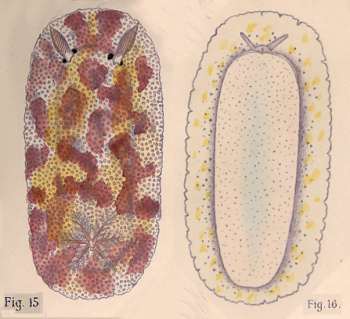
Discodoris schmeltziana
Bergh, 1880
Order: NUDIBRANCHIA
Suborder: DORIDINA
Superfamily: EUDORIDOIDEA
Family: Dorididae
DISTRIBUTION
Known from western Pacific. Also reported in the Forum from the Red Sea.
PHOTO
Upper: Gonubalabala Island, Milne Bay Province, Papua New Guinea. Depth: 12 m. Length: about 40 mm. 21 Jan 2005. Sand slope with patch reef. Photographer: Mary Jane Adams.
Lower: Bergh, 1880: Plate A. figs 15-16.
Somewhat similar in shape to Discodoris boholiensis, the main colour difference are the patches of pale purple or lilac tubercles, usually surrounded by a region of yellowish tubercles.
Originally described from the Society Islands, French Polynesia, it has recently been reported from Japan and the Philippines [http://slugsite.us/bow/nudwk434.htm], and here f rom Papua New Guinea.
Although published as a name in a list in Bergh, 1877, Discodoris schmeltziana was not properly described until 1880.
-
Bergh, L. S. R. (1877) Malacologische Untersuchungen. In C. G. Semper (Ed.) Reisen im Archipel der Philippinen, Zweiter Theil, Wissenschaftliche Resultate, Band 2, Theil 2, Heft 12, (pp. 495 - 546).
-
Bergh, L.S.R. (1880) Malacologische Untersuchungen. In: C.G. Semper, Reisen im Archipel der Philippinen, Wissenschaftliche Resultate. Band 2, Suppl. 1, 1-78, Pls. A-F.
Rudman, W.B., 2005 (March 8) Discodoris schmeltziana Bergh, 1880. [In] Sea Slug Forum. Australian Museum, Sydney. Available from http://www.seaslugforum.net/find/discschm
Related messages
Discodoris schmeltziana found sthn Queensland
November 17, 2009
From: Gary Cobb
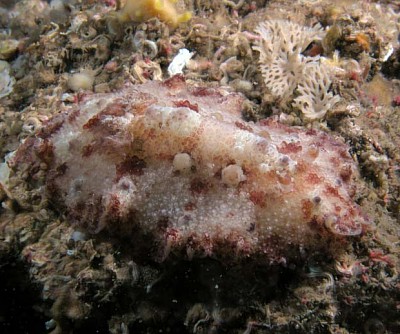
Concerning message #19164:
Hi Bill and everyone!
Diving at Old Woman Island again has proven successful. After only 8 minutes of diving I found 8 species. Shortly after that I turned over a rock and found Discodoris schmeltziana with it's egg mass.
Locality: Old Woman Island, Mudjimba Beach, 12 m depth, Queensland, Australia, Pacific Ocean, 07 November 2009, Subtidal. Length: 85 mm long. Photographer: Gary Cobb.
Under natural light you can see the faint purple spots around the mantle margin. Where did the name come from?
Cheers
Gary
PS. we have found another 3 new species the next day which brings our total to 403 species. When will it stop?
gary@nudibranch.com.au


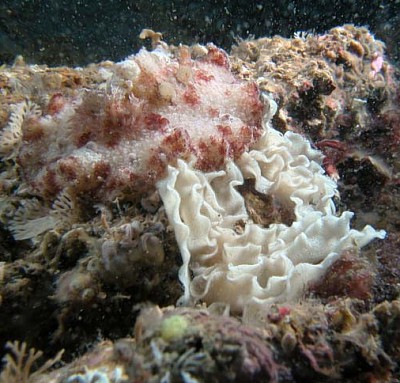
Dear Gary,
Your question about who was Schmeltz, raises an interesting example of how early European scientists obtained their 'exotic' specimens.
Dr. Johann Schmeltz was director of the Museum Godeffroy in Hamburg between 1861-82.
Capt Godeffroy was a wealthy trader and shipping magnate wtih shipping and trading interests in the Pacific and Australian regions, including the collecting, preparation and sale of biological and ethnographical specimens which were then sold throughout Europe and Nth American museums and universities. He had a virtual monopoly on human skulls and bones which were big business amongst European anthroplogists of the time. The company also funded collectorsof biological specimens. One of particular fame for opisthobranch enthusiasts was the collector Andrew Garrett [Risbecia tryoni] much of whose material was worked on by Rudolph Bergh [hence Risbecia godeffroyana and Discodoris schmeltziana].
The Semper brothers, one of whom [C. G. Semper] edited the voluminous Reisen im Archipel der Philippinen in which Bergh published much of his work, were also part of the Godeffroy 'gang'. The zoological collections in this museum was sold to the Zoological Museum of Hamburg in 1886 after the Godeffroy company struck financial trouble.
Best wishes,
Bill Rudman
Discodoris schmeltziana ? from East Timor
May 21, 2007
From: Brian Francisco
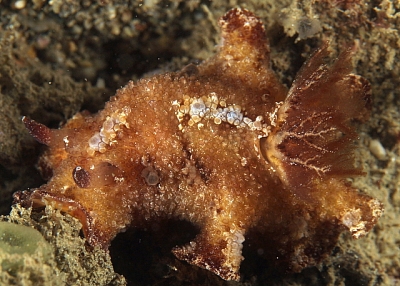

Bill
After looking at a thousand photos on the Species List, my best guess is that this is Discodoris schmeltziana. Or maybe an Archidoris?
Locality: Tasi Tolu, 17 meters, East Timor, Banda Sea, 05 January 2007, sandy, rubble slope. Length: 3-4 cm. Photographer: Brian Francisco.
Thanks for your help.
Brian
francisco.brian@gmail.com
Francisco, B., 2007 (May 21) Discodoris schmeltziana ? from East Timor. [Message in] Sea Slug Forum. Australian Museum, Sydney. Available from http://www.seaslugforum.net/find/19164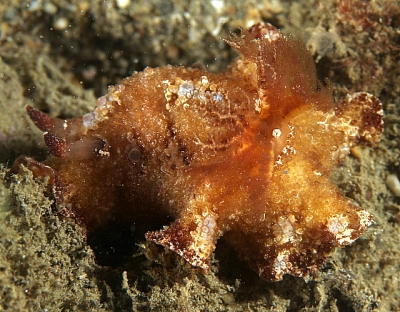
Dear Brian,
Yes this is Discodoris schmeltziana. Sorry its a bit of a struggle finding things. I have a half-finished key to help you narrow down the field but I am afraid I never seem to get a chance to finish it - even catching up on old messages is proving very difficult.
Best wishes,
Bill Rudman
Discodoris schmeltziana from the Red Sea
March 24, 2005
From: Binyamin Koretz

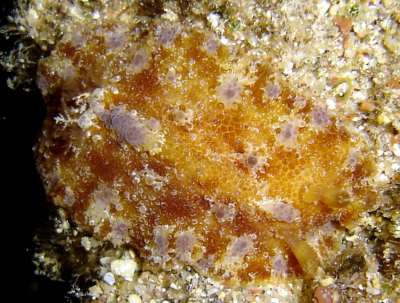
Dear Bill,
Quite a surprise - 10 days after this nudibranch [Discodoris schmeltziana ] made its first appearance on the Forum from PNG and Hawai'i, we found it here in Eilat, crawling on dead coral in barely 2 meters of water.
Locality: Eilat, Malibu Beach, Israel, Red Sea (Gulf of Eilat). Depth: 2 m. Length: ca. 5 cm. 21 March 2005. mostly dead coral (reef table). Photographer: Binyamin and Shulamit Koretz
Best regards
Binyamin
binyamin@koretz.net
Koretz, B., 2005 (Mar 24) Discodoris schmeltziana from the Red Sea. [Message in] Sea Slug Forum. Australian Museum, Sydney. Available from http://www.seaslugforum.net/find/13405Dear Binyamin,
Discodoris schmeltziana in the Red Sea! - It's all part of my sophisticated marketing campaign to get people interested in the Forum - I have people dropping this species at strange places around the world!
Joking aside, it is certainly interesting to get a record from the Indian Ocean region. I have been wondering if any of Eliot's dorids from East Africa or Alder & Hancock's from India were the same.and I suspect Peltodoris aurea Eliot, 1904, based on 3 small specimens approx 2 cm long, from Wasin Is., Kenya, are this species.
-
Eliot, C.N.E. (1904) On some nudibranchs from East Africa and Zanzibar. Part III. Dorididae Cryptobranchiatae, I. Proceedings of the Zoological Society of London, 1903(2): 354-385, Pls.32-34.
Best wishes,
Bill Rudman
Discodoris schmeltziana from Okinawa
March 23, 2005
From: Robert F. Bolland

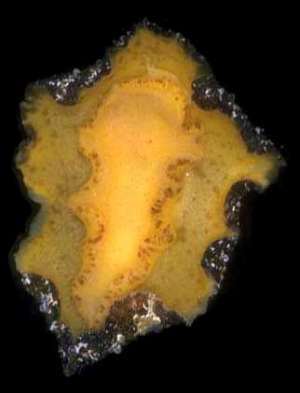
Hi Bill,
Thought I'd add another pair of photos of Discodoris schmeltziana from Okinawa. One of the images shows the yellow foot similar to one of Cory Pittman's images posted on the Forum [#13324 ] from Hawaii.
Locality: Seragaki, Okinawa, Japan. Depth: 1.5 m. Length: 55 mm. 12 May 1989. From beneath a slab of coral rubble during a daytime dive. Photographer: Bob Bolland [RFB #2157 (both images of the same animal)]
Cheers,
Bob
bollandr@rapid-link.ne.jp
Bolland, Bob, 2005 (Mar 23) Discodoris schmeltziana from Okinawa. [Message in] Sea Slug Forum. Australian Museum, Sydney. Available from http://www.seaslugforum.net/find/13374Thanks Bob,
Best wishes,
Bill Rudman
Re: Discodoris schmeltziana from Hawaii
March 12, 2005
From: Cory Pittman

Dear Bill,
Here're some shots of a Discodoris schmeltziana from Maui, Hawaii collected on October 11, 2003. Pauline Fiene found it under a waterlogged log at a depth of 9-14 m while we were diving in a Halimeda incrassata bed about 3.5 km north of Hekili Point. The photos are mine. The third shot is a crop of a close-up included to confirm that the brown flecks are pigment rather than debris. The size wasn't recorded (it was one on those "I thought she'd measured it and she thought I had" situations) but I recall it as around 25 to 30 mm.
Locality: about 3.5 km north of Lahaina, Maui, Hawaii, USA. Depth: 9 to 14 meters. Length: about 25 to 30 mm. 11 October 2003. Halimeda incrassata bed growing in sand with some scattered coral rubble and debris. Photographer: Cory Pittman
Glad the forum is back up!
Best wishes,
Cory
cory@cet.com
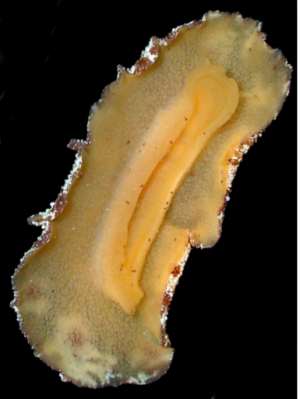
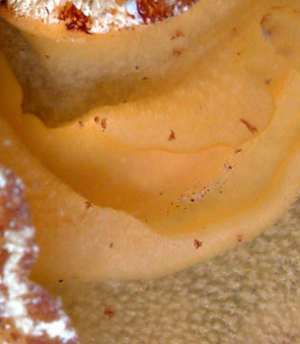
Dear Cory,
Thanks for these photos, especially the underside. There seems to be a number of species with this bright yellow underside. It is interesting how the underside of the mantle is translucent with a close speckling of irregular yellowish patches. I guess the white underside with large yellow spots and small dark spots in the original painting [by Garrett I assume] is artistic licence?
Best wishes,
Bill Rudman
Re: Discodoris schmeltziana from Papua New Guinea
March 11, 2005
From: Kathe R. Jensen
Dear Bill,
When I saw your Fact Sheet to Discodoris schmeltziana, I remembered that when I was compiling the type catalogue of Bergh's types in the Zoological Museum, I also made some notes on the nomina nuda generated by Bergh. I looked in these notes, and it appears that this species is more complicated than just the 2 publications you have listed. Apparently Bergh had in 1877-78 so many papers in various stages of publication that he made species lists in foot-notes of several of these papers. According to my notes (I haven't had time to look at the original papers), Bergh published a list of new Discodoris species on p. 61 in:
Bergh, R. 1877. Kritische Untersuchung der Ehrenberg'schen Doriden. Jb. deutsch. Malakozool. Ges. 4: 45-76.
In this list he has Discodoris schmeltziana and he attributes this species to Garrett. This species was also mentioned in the issue of Semper's Reisen that you have listed (p. 519). Furthermore figures were published in J. Mus. Godeffroy, Heft 8 (1875, Plate 8) and Heft 14 (1878, Plate 5). You are quite right in stating that the species description did not appear until 1880 in the Supplement to Semper's Reisen.
I have a feeling that it was cases like this that made people decide to have strict rules for nomenclature.
Best wishes,
Kathe
krjensen@zmuc.ku.dk
Jensen, K.R., 2005 (Mar 11) Re: Discodoris schmeltziana from Papua New Guinea. [Message in] Sea Slug Forum. Australian Museum, Sydney. Available from http://www.seaslugforum.net/find/13319Thanks Kathe,
Bergh certainly made some things very difficult for us.
Best wishes,
Bill Rudman
Discodoris schmeltziana from Hawaii
March 11, 2005
From: Scott Johnson
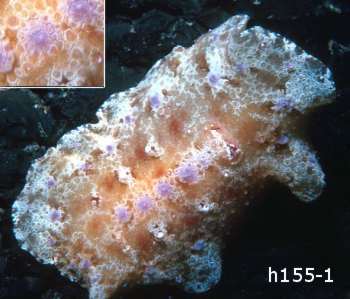
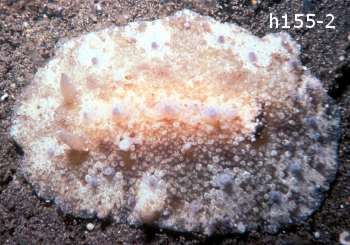
Hi Bill,
Mary Jane Adams' photo [#13257] of Discodoris schmeltziana brought to mind this animal observed occasionally in the Hawaiian Islands. Alas, I did not take a photo of its underside, and my color notes of that portion of the body say only "Foot bright lemon yellow." The locality details refer to the animal h155-1. The animal shown in h155-2 was photographed by Stan Jazwinski, I believe off the island of Maui, Hawaii.
Locality: [for h155-1] Halona Point Blowhole, Oahu Island, Hawaii, USA. Depth: 15 m. Length: 40 x 20 mm. 23 February 1980.Sparse coral reef on lava. Photographer: Scott Johnson [for h155-1] / Stan Jazwinski [for h155-2 ]
Scott
uwkwaj@yahoo.com
Johnson, S., 2005 (Mar 11) Discodoris schmeltziana from Hawaii. [Message in] Sea Slug Forum. Australian Museum, Sydney. Available from http://www.seaslugforum.net/find/13323Thanks Scott,
It's good to get an idea of some of the colour variability to be found in the species.
Bill Rudman
Discodoris schmeltziana from Papua New Guinea
March 9, 2005
From: Mary Jane Adams

Hi Bill,
I have used the Forum dozens of times to help me ID my nudibranch photos. It is very helpful to have images of multiple specimens from different localities to show variations in size and color pattern. This is one I couldn't find on the Forum so I asked to Terry Gosliner to identify it for me. He said it is Discodoris schmeltziana, Bergh, 1877. It looks a lot like D. boholiensis except for the purple tubercles surrounded by yellow ones.
Locality: Gonubalabala Island, Milne Bay Province, Papua New Guinea. Depth: 12 m. Length: about 40 mm. 21 Jan 2005. Sand slope with patch reef. Photographer: Mary Jane Adams
Best regards,
Mary Jane
divepng@yahoo.com
Adams, M.J., 2005 (Mar 9) Discodoris schmeltziana from Papua New Guinea. [Message in] Sea Slug Forum. Australian Museum, Sydney. Available from http://www.seaslugforum.net/find/13257
Dear Mary Jane,
Thanks for a new species for the Forum. I've prepared a brief Fact Sheet on the species, and included the original colour paintings of the animal. My understanding is that Discodoris schmeltziana Bergh, 1877 is just a name in a list and it wasn't validly used until 1880. It would be interesting to know how accurate the painting of the colour of the underside of the mantle and the foot is. It certainly looks quite distinctive. Have you by chance a photo showing the underside?
Best wishes,
Bill Rudman
